2016 Toyota Prius: First Drive
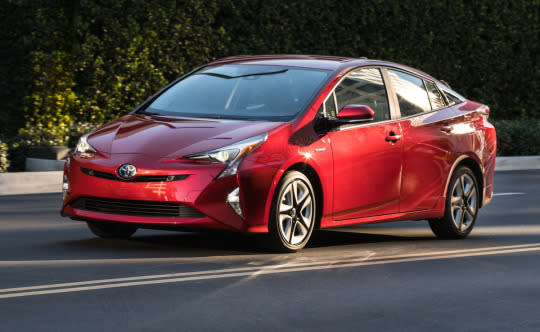
We sent an ardent fan of Toyota’s best-selling hybrid to test whether the new edition moved the car forward, or just complicated its style.
What Is It? The 2016 Toyota Prius, the fourth generation of the world’s most popular hybrid sedan.
Starting Price: $24,200-$30,000.
Competitors: None. The Prius sells seven times better than its nearest hybrid-segment competitor, even in this, the last year of its lifecycle.
Alternatives: Nissan Leaf, BMW i3, Hyundai Sonata Hybrid.
Pros: Best fuel economy on Earth outside of pure electric cars or the Porsche 918 hybrid supercar; improved handling and ride feel, updated tech and interior.
Cons: Slow 0-60 time, cheesy exterior resdesign.
Would I buy it with my own money? I have before, and will again.
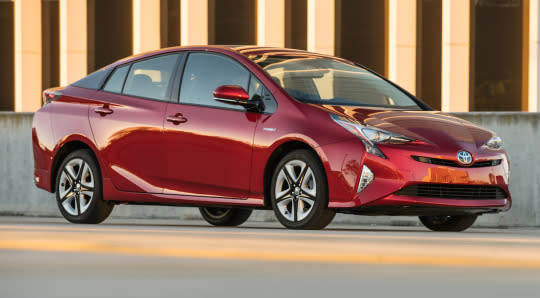
You’d be hard-pressed to find another car writer who enjoys driving a Prius, much less owns one. Yet here I am, on my third model. My wife and I got our first Prius in 2006, when gas prices were through the ceiling, and we’re still rolling slowly along through the city where a gallon of gas is cheaper than a pack of gum. But I have to admit that I’ve grown tired of my current ride, a 2013 model, which feels increasingly fusty and dated, like a pair of old slippers or worn-out wallpaper in a teardown house. The tech looks like it belongs in a low-rent 1990s cyber-thriller, the ride quality feels unspeakably bad by contemporary standards. Every time a new hybrid or electric appears in my driveway for me to test, the Prius lessens in my estimation a little more. Even an ordinary if pleasant machine like the Hyundai Sonata Hybrid makes me feel slight pangs for what could be.
So when I test drove the fourth generation Prius this week in Southern California, it wasn’t just as a reviewer, it was as a dissafected brand loyalist. I wanted Toyota to show me why I should stay with the car. Much to my satisfaction, they’ve addressed most of the current model’s problems. The Prius may no longer be the cutting-edge machine it was when it debuted, but this new model at least brings it back into modernity, while improving on the qualities that made it a success in the first place.
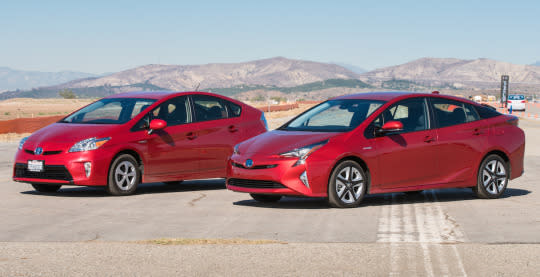
The exterior of the fourth-gen Prius is probably the least successful aspect of the redo. Toyota has taken the iconic shape of the original model and brought it lower to the ground, adding in all kinds of cuts and slashes in a weak imitation of cool. It feels like a business executive trying to do a rap at a weekend corporate retreat—I’m the Toyota Prius/and I’m here to say/I’m the best damn hybrid in the U-S-A.
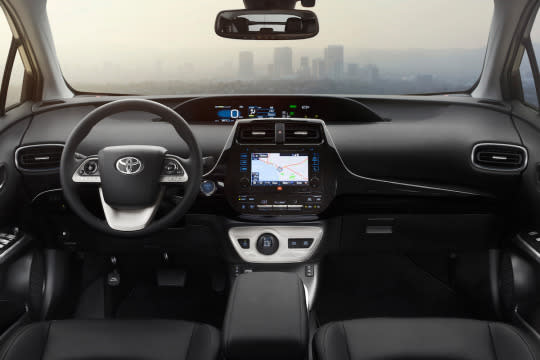
But the interior design is much more successful. Sitting in the current model feels like waiting in a low-rent dental clinic. It’s a dispiriting mound of light-brown plastic. The new one has smoother lines, a lower dashboard, more angular seating, and more window space leading to vastly improved sightlines. Gone is the pale-green old-timey calculator dashboard readout, replaced by a modern, multicolored one. There’s a nice 4.2-inch display screen, and, on higher-trim models, an Imperial Stormtrooper white-plastic center console that comes complete with a wireless charging pad for Android phones.
But you’d expect a tech and design update in a car that hasn’t been significantly refreshed since 2009. Anything less would have been laughable. More surprisingly, the new Prius actually drives better. This is the first car to be constructed with the Toyota New Global Architecture Platform, designed to improve body and powertrain components across the lineup. They’ve lowered the Prius’ center of gravity by a full inch. The car is also 2.24 inches longer and about a half-inch wider. It has a new double-wishbone rear suspension, a 60 percent increase in torsional rigidity, more high-strength steel throughout, an automatic grille shutter to control airflow to the engine, and continuous soundproofing, including a full array of underbody panels.
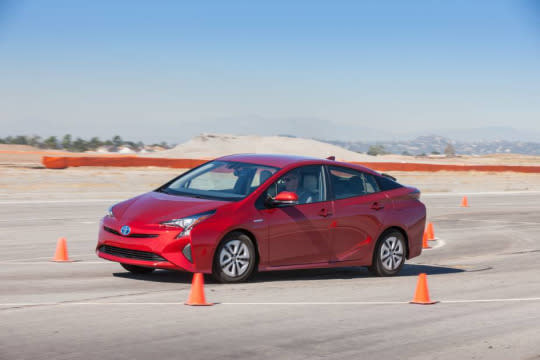
While all of that sounds suspiciously like “things that are in a car,” it’s positively revolutionary in the Prius, which previously sacrificed everything at the altar of the fuel-economy gods. I drove the new Prius on a 60-mile run through some twisty mountain roads, and while the drive experience may not have been the bleeding edge of fun, it was at least pleasant, which is more than I can say about the nausea-inducing dullness of the current model. Toyota put me on a reasonably difficult autocross course in the Prius as well. Prius and “sharp turn executed with intuitive steering and quality braking” feels weird to type, but it handled everything brilliantly. By comparison, I did the same course in a 2013 Prius that was a lot like the one I own, and it barely made it through without knocking over a dozen cones. The old Prius drives like a Segway. This new one feels like an actual car.
The new Prius gets an archetypically weak 121 horsepower, pairing a 1.8-liter 4-cylinder Atkinson cycle engine with a battery that generates 600 volts, paired with an electronically-controlled continuously variable transmission. The base Prius 2 model comes with a nickel-metal hydride battery, while a special Prius 2 “Eco” model and the up-market Prius 3 and 4 trims come with a lithium-ion battery.
All of that leads to the Prius money shot, the gas mileage: It falls short of the much-rumored 60 mpg mark. Non-Eco grades average 54 city, 50 highway, and 52 mpg overall. The Prius 2 Eco gets closer, at 58/53/56, achieved by removing the spare tire, lightening the weight of the vehicle by 65 pounds. And that gas mileage isn’t a mythic figure either, only to be achieved by expert hyper-milers. I drove the Prius 2 and the Prius 4, and also looked at stored trips on the shipboard computer. The trip numbers Impressed: 55.4, 54.1, and even, for one glorious 20-mile jag down the coast, 66.8 MPG. For all its improvements, the Prius clearly hasn’t deviated from its core fuel-economy mission. Gas may be less than $2 a gallon (at least where I live), but the Prius is well-positioned to take advantage when prices spike and people realize that their impulsive light-truck purchase might not have been so wise after all.
Also updated: A tremendous 11-speaker JDL audio system on the high-trim Prius 4, and a complete safety package, including all manner of collision alerts, lane departure warnings, and pedestrian and vehicle detection systems, only a $500 upcharge as part of a safety package. The Prius also now comes optional with an advanced cruise control system, which debuted in the Lexus LS a couple of years ago, but has already trickled down the food chain.
So we now have a Prius that can essentially drive itself and gets 54 MPG. All my dreams have been realized. My current model’s lease expires next May. I’ve been thinking about buying it out, but that would doom me to a decade or so in the automotive gulag, the thought of which deadens my soul. The price for the Prius 2 starts at $24,700, the Eco is $24,700, and the Prius Four Touring with 17-inch wheels comes in at $30,000. Maybe, given the SUV-mania that continues to grip the U.S. like a virulent fever, I’ll be able to get a decent deal on a lease. Now that I’ve driven the new Prius, it’ll be hard to go back.

 Yahoo Finance
Yahoo Finance 